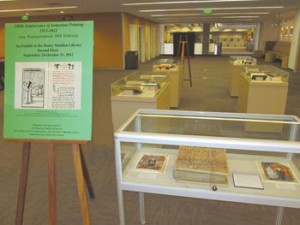Andrew Esguerra
Staff Writer

Photo: Barlow Der Mugrdechian
From the Library of Congress in Washington, D.C., to the Armenian Library and Museum of America in Watertown, Massachusetts, from Venice to Yerevan and now at Fresno State, celebrations this past year have taken place worldwide marking the 500th anniversary of the printing of the first Armenian book.
The Armenian Studies Program has organized an exhibit on “The 500th Anniversary of Armenian Printing” on the second floor of the Fresno State Henry Madden Library and will host a special reception from 2-5PM on Sunday, October 14 to mark its official opening. The exhibit is co-sponsored by the Armenian Studies Program, the College of Arts and Humanities, and the Henry Madden Library.
Special guest speaker for the day will be Dr. Kevork Bardakjian, Marie Manoogian Professor of Modern Armenian Language and Literature at the University of Michigan, Ann Arbor, who will speak on “The Impact of the Armenian Script and Printing on Armenian Identity and Letters.” Fresno State President Dr. John Welty, Provost Dr. William Covino, and Dean of the College of Arts and Humanities, Dr. Vida Samiian, will also be present at the afternoon reception.
The exhibit can be viewed during regular Henry Madden Library hours, from October 1-31. Go to the Madden Library website for specific information http://www.fresnostate.edu/library/. The exhibit is free and open to the public.
The 1512 Urbatagirk (The Book of Friday Prayers) published by Hakob Meghapart in Venice, was the first printed work in Armenian, and utilized a new technology, the movable printing press that would generate a new chapter in the Armenian literary tradition by exposing a wider audience of Armenian speakers to intellectual trends.
The Armenian Studies Program exhibit features rare printed books and several examples of earlier manuscripts from the Armenian Studies Program collection. The majority of the printed works are from the Parnay Collection, 300 19th and 20th century works, the majority published by the Armenian Mkhitarist congregation of Venice, but also including books from Constantinople, Tiflis, and elsewhere, now part of the Armenian Studies Program. Mr. Ray Parnay donated the collection, once belonging to his late father Mardig and late uncle Serope Y. Parnay (Yedi-Kardashian), in 2006.
A 1782 “Guidebook to the Holy Places of Jerusalem” is the oldest book on display. Other works include a translation of Homer’s Iliad (1843), an 1859 History of Vartan and the Armenian Wars by Yeghishe, and A Geography of Place Names of Greater Armenia (1855) by Very Rev. Fr. Ghevond Alishan.
On display also is a special facsimile reproduction of the 9th century “Etchmiadzin Gospel” (Codex Etchmiadzin) on loan from the collection of Arminee Shishmanian and the late Dr. Leo Shishmanian of Fresno. The “Etchmiadzin Gospel” contains the “Final Four Miniatures,” the earliest known Armenian miniature paintings, dated to the late 6th or early 7th century.
Just as the creation of the Armenian alphabet by St. Mesrob Mashtots allowed for Christianity to be spread and taught in Armenian, the printing press would allow the works of Armenian authors to proliferate.
On the world stage, this revolutionary catalyst for the Armenian literary movement has not gone unnoticed. Yerevan was proclaimed the Book Capital of the Year of 2012 by the United Nations Educational, Scientific and Cultural Organization (UNESCO). In addition, Yerevan itself has played host to many exhibitions and events during this past year.
 Hye Sharzhoom Armenian Action
Hye Sharzhoom Armenian Action